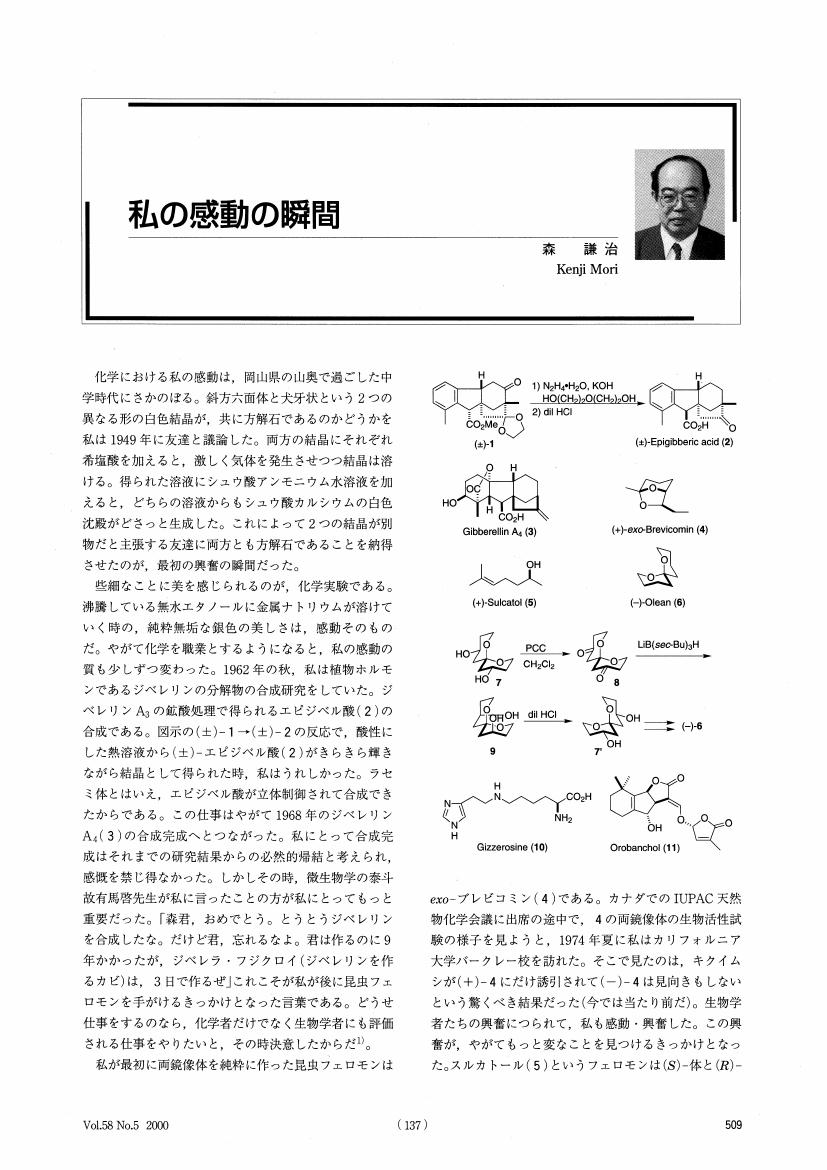2 0 0 0 OA 天然物合成における微生物や酵素の利用
- 著者
- 森 謙治 須貝 威
- 出版者
- The Society of Synthetic Organic Chemistry, Japan
- 雑誌
- 有機合成化学協会誌 (ISSN:00379980)
- 巻号頁・発行日
- vol.41, no.11, pp.1044-1053, 1983-11-01 (Released:2009-11-13)
- 参考文献数
- 55
- 被引用文献数
- 12 16
Recent examples in the applications of biochemical systems in the syntheses of natural products are reviewed with special emphasis on the enantioselectivities of biochemical reactions.
2 0 0 0 OA サリン事件と私
- 著者
- 森 謙治
- 出版者
- The Society of Synthetic Organic Chemistry, Japan
- 雑誌
- 有機合成化学協会誌 (ISSN:00379980)
- 巻号頁・発行日
- vol.53, no.10, pp.917-918, 1995 (Released:2009-11-16)
1 0 0 0 OA 昆虫フェロモン合成の最近の進歩
- 著者
- 森 謙治
- 出版者
- The Society of Synthetic Organic Chemistry, Japan
- 雑誌
- 有機合成化学協会誌 (ISSN:00379980)
- 巻号頁・発行日
- vol.40, no.11, pp.1068-1075, 1982-11-01 (Released:2010-01-22)
- 参考文献数
- 45
- 被引用文献数
- 2 2
Advances in the synthesis of achiral and chiral pheromones are reviewed with emphasis on modern synthetic methodologies.
1 0 0 0 OA 光学活性昆虫フェロモンの合成
- 著者
- 森 謙治
- 出版者
- The Society of Synthetic Organic Chemistry, Japan
- 雑誌
- 有機合成化学協会誌 (ISSN:00379980)
- 巻号頁・発行日
- vol.39, no.1, pp.63-72, 1981-01-01 (Released:2009-11-13)
- 参考文献数
- 35
- 被引用文献数
- 4 6
Synthesis and biological activity of several chiral pheromones are discussed with emphasis on the synthetic strategies such as derivation from optically active natural products, optical resolution of intermediates and asymmetric synthesis using biochemical systems.
1 0 0 0 OA 有機合成は生合成にどこまで迫りうるか
- 著者
- 森 謙治
- 出版者
- 公益社団法人 日本農芸化学会
- 雑誌
- 化学と生物 (ISSN:0453073X)
- 巻号頁・発行日
- vol.12, no.5, pp.329-332, 1974-05-25 (Released:2009-05-25)
1 0 0 0 OA 私の感動の瞬間
- 著者
- 森 謙治
- 出版者
- 公益社団法人 有機合成化学協会
- 雑誌
- 有機合成化学協会誌 (ISSN:00379980)
- 巻号頁・発行日
- vol.58, no.5, pp.509-510, 2000-05-01 (Released:2009-11-13)
- 参考文献数
- 4
- 著者
- 滝川 浩郷 森 謙治 木戸 勝 Albizati K. F. Faulkner D. J.
- 出版者
- 天然有機化合物討論会実行委員会
- 雑誌
- 天然有機化合物討論会講演要旨集
- 巻号頁・発行日
- vol.34, pp.707-714, 1992
In 1985, limatulone (1a and 1b) was isolated from the intertidal limpet Collisella limatula, and found to inhibit fish and crab predation. It is the most potent fish feeding inhibitor and is about an order of magnitude more effective than polygodial. Although the natural limatulone was optically inactive, it was not clear whether it was a meso-compound (1a) or a racemate (1b). We therefore decided to confirm the structure by a total synthesis. The known 3, which was obtained from the starting material (2) in 4 steps, was alkylated with BrCH_2CO_2Et to give 4a. The corresponding acid 4b was employed for the lactone-ring formation to give a stereoisomeric mixture of lactones 5a and 5b. After separation, lactone 5a was converted to the coupling-partners 10 and 11 via 6, respectively. The carbanion derived from 11 was alkylated with 10 to give a complex mixture, which was desulfonylated with Na-Hg to give a mixture of 12a and 12b. This was converted to a separable mixture of 13a and 13b. Fortunately, the structure of the less polar isomer could be solved by an X-ray analysis. An aldehyde 15a, which was prepared from 13a in 3steps, was treated with ClCH_2Li to give bis-epoxide 16a. Epoxide-opening of 16a by a Grignard reagent gave 17a. Swern oxidation of 17a to 18a was followed by removal of the EE protective groups to give meso-limatulone (1a), (overall yield: 0.62% from 2 in 24 steps). Similarly, (±)-13b was converted to (±)-limatulone (1b), (overall yield: 0.39% from 2 in 24 steps). The ^1H-NMR spectrum of the reported limatulone was identical to that of (±)-limatulone (1b). To our surprise, however, another fraction from the HPLC of Collisella limatula showed the ^1H-NMR spectrum superimposable on that of meso-limatulone (1a). Accordingly, Collisella limatula produces both meso-1a and (±)-1b.


